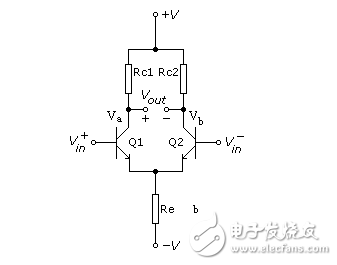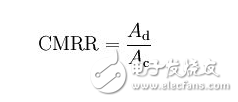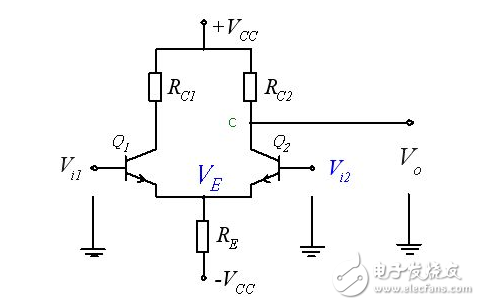A differential amplifier, also called a differential amplifier, is an electronic amplifier that amplifies the difference between the voltages at the two input terminals with a fixed gain, sometimes simply referred to as "difference amplifier". Differential amplifiers are commonly used as input stages of power amplifiers (referred to as "power amplifiers") and emitter-coupled logic circuits (ECL).

If the characteristics of Q1 Q2 are very similar, then Va, Vb will also change. For example, Va changes by + 1V, and Vb also changes by + 1V, because the output voltage VOUT = Va-Vb = 0V, that is, changes in Va and Vb cancel each other out. This is why the differential amplifier can amplify the DC signal. If the two inputs of the difference are ![]() , Then its output Vout is:
, Then its output Vout is:

Where Ad is differential mode gain (differenTIal-mode gain) and Ac is common mode gain (common-mode gain).
Therefore, in order to improve the signal / noise ratio, the differential magnification should be increased and the common mode magnification should be reduced. The ratio of the two is called the common-mode rejection ratio (CMRR, common-mode rejecTIon raTIo). The common mode magnification AC can be obtained by the following formula:
Ac = 2Rl / 2Re
The common-mode rejection ratio (CMRR), the ratio of differential-mode gain and common-mode gain, is usually used to measure the ability of differential amplifiers to eliminate common-mode signals:

From the above equation, when the common mode gain Ac → 0, CMRR → ∞. The larger Re is, the lower Ac is, so the common mode rejection ratio is also larger. So for a fully symmetrical differential amplifier, Ac = 0, so the output voltage can be expressed as:

The so-called common mode amplification factor is the amplification factor when Va and Vb input the same signal. If the common-mode amplification factor is 0, the input noise has no effect on the output.
To reduce the common mode magnification, increase RE. Usually use a constant current circuit with large internal resistance to replace RE
The differential amplifier is a generalization of the common single-ended input amplifier. As long as one input terminal of the differential amplifier is grounded, the single-ended input amplifier can be obtained. Many systems input a feedback signal at one input of the differential amplifier and a feedback signal at the other input to achieve negative feedback. Commonly used for motor or servo motor control, regulated power supply, measuring instruments and signal amplification. In discrete electronics, a common method of implementing differential amplifiers is differential amplification, which is found in differential circuits in most op amp integrated circuits.
Single-end output differential amplifier circuit (unbalanced output)

When Vo is taken out from the collector C of Q1 or Q2 to ground, it is called single ended Single ended or Unbalance Output.
Single-ended is twice as small as the differential output. When using single-ended output, the common-mode signal cannot be suppressed. Because Vi1 and Vi2 increase at the same time, VC1 and VC2 decrease, and VC1 = VC2, but Vo = VC2, not Zero (resulting in zero drift).
However, increasing the resistance of RE can increase the negative feedback and suppress the output, and suppress the common mode signal. When Vi1 = Vi2, Ii1 and Ii2 also increase at the same time, and IE also increases and VE increases, which causes Q1 and Q2. Negative feedback reduces the gain of Q1 and Q2, that is, Vo decreases.
When the differential signal is input, Vi1 = -Vi2, IC1 increases and IC2 decreases, the total current IE = IC1 + IC2 remains unchanged, so VE also remains unchanged, the circuit that increases the resistance value of RE will amplify the differential signal, not It will produce negative feedback and suppression for Q1 and Q2.
If you are tired of the original back of your phone, you should try our 3D Relief Back Sticker. The Back Skin Protective Film on the back can not only bring you a visual change, but also protect the back cover of the phone itself from scratches and collisions. Real 3D touch, personalized and stylish pattern design. Bring you a perfect experience.
In daily use, it can protect the equipment from scratches, dust, impact and other damage.
Long-lasting anti-scratch effect, significantly reducing dust, oil stains and fingerprint stains.
Easy to install, easy to stick to the back of the phone, and will not damage the original appearance of the phone.
With the Protective Film Cutting Machine, you can install the Back Film on different types of mobile phone back shells, including mobile phones, tablet computers and other electronic products. Customization can be completed in 30 seconds with just one click.
If you want to know more about 3D Relief Back Sticker, please click product details to view the parameters, models, pictures, prices and other information about 3D Relief Back Sticker.
Whether you are a group or an individual, we will try our best to provide you with accurate and comprehensive information about 3D Relief Back Sticker!
3D Phone Sticker, Carbon Fiber Back Sticker, 3D Relief Back Sticker, 3D Printing Back Sticker, Phone Skin,Mobile Phone Back Sticker
Shenzhen Jianjiantong Technology Co., Ltd. , https://www.jjtbackskin.com